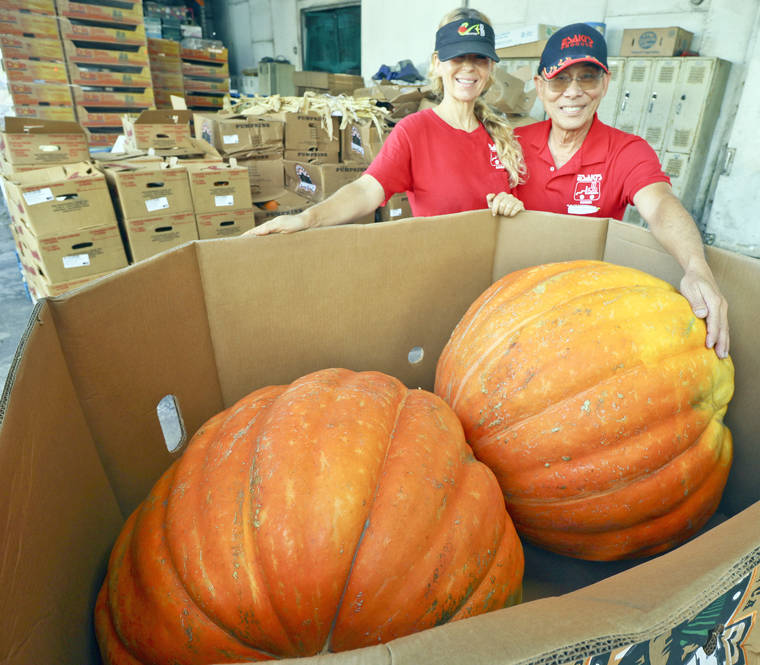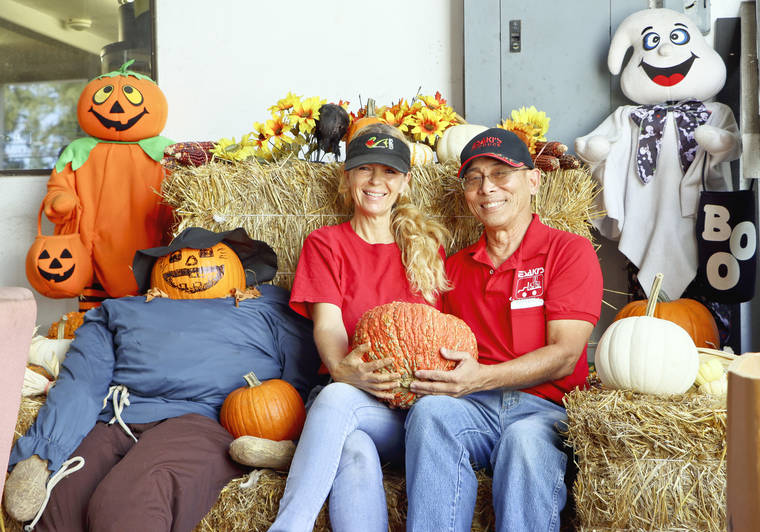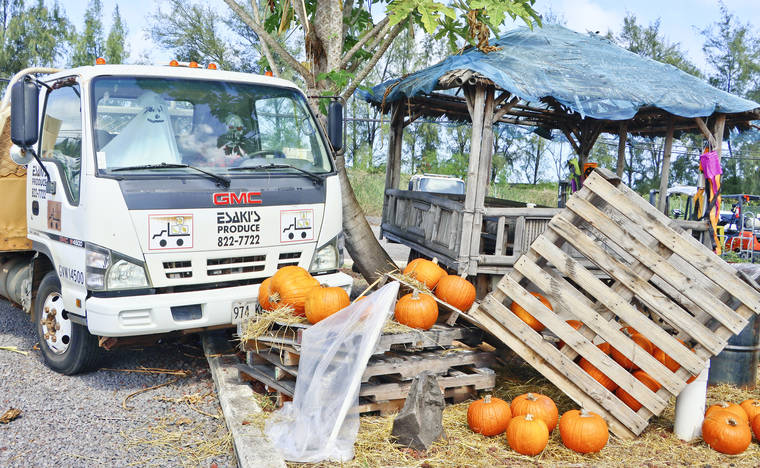Pumpkins don’t like wet feet, said Earl Kashiwagi, eneral manager of Esaki’s Produce. They explode!
“Remember when we had that farmer growing pumpkins in Kapahi?” Kashiwagi said. “He put buffalo grass as a buffer, but still had losses. The success of this year’s Harvest Ag Festival was because the pumpkins were grown closer to the Polihale area where there is less rain. Previously, they were growing the pumpkins closer to Kaumakani and one year, lost about half of what they grew because of the rain.”
Kashiwagi, whose favorite time of the year is Halloween, said the fall festival marks the start of the holiday season for the Kapaa produce wholesaler.
“We have the materials in to take care of Halloween,” he said. “Once that is done, we can roll over some of the things into Thanksgiving, adding to the cranberries that we order in September. Following Thanksgiving, we have Christmas rolling in, and a week later, it’s New Year’s where we need to have a lot of the Oriental things like mizuna. All of those celebrations call for parties and food.”
Kashiwagi considers Esaki’s Produce to be not just a wholesale produce operation, but instead a wholesaler, distributor, and even a broker.
“We are the link between farm to table,” he said. “Our drivers know — we leave the warehouse full, and when they come back, their trucks are also full. They deliver, and pick up more items on the return trip.”
Pumpkins found in the bigger retail stores are stored at the Esaki’s warehouse until the proper time for delivery.
“We’re basically a 24-hour operation,” Kashiwagi said. “When we need to deliver to the bigger accounts, the drivers go out late at night to avoid the traffic.”
Produce is a “casino game,” Kashiwagi said. “Everyone who works at Esaki’s is family. They need to work together and develop chemistry that has no friction.”
During Halloween, Kashiwagi says he develops a theme and assigns different sections of the wholesale operation to carry out the overall display that welcomes shoppers to the Kapaa facility. The display is also visible from the road for others to enjoy.
“I like Halloween,” Kashiwagi said. “We have people like Hele Bermudez who came from Denmark who have never experienced Halloween. She learns about the festivities by being involved.”
Previously, Kashiwagi remembers when he had a pair of girls from Thailand who had never heard of Halloween until they started working for Esaki’s.
“We have Halloween in Denmark,” Bermudez said. “People dress up and children go house to house, but we don’t do pumpkins. The biggest grown pumpkin in 2019, according to the Guinness Book of World Records weighed in at 2,624 pounds. And, it was grown in Belgium which is the neighboring country to Denmark. Why don’t we do pumpkins?”
The biggest pumpkins waiting delivery at the Esaki’s warehouse tips the scale at 300 pounds — mere babies compared to the Guinness heavyweight.
“These go out to customers who order them special,” Kashiwagi said. “It’s like Christmas when certain customers require special products and goods.”
Other specialties include dried corn stalks which can be moved over for Thanksgiving displays.
“We have dried corn, here on Kauai,” Kashiwagi said. “But we don’t dry them enough and they go bad.”
Bermudez said the closest holiday to Halloween celebrating in Denmark is Easter.
“It’s the same with Valentine’s Day,” Bermudez said. “It must be an American thing.”
Kashiwagi said everything started in 1923 with Buhachi Esaki, who used to work with the pineapple company.
“He raised watermelon with the kids,” Kashiwagi said. “He farmed in Papa‘a Valley. In 1948, he moved to Anahola with his warehouse next to where Duane’s Ono Char Burgers is. The farm was in Aliomanu.”
“In 1951, he moved to Anahola,” Kashiwagi said. “By that time, he was growing 35 different crops, including lettuce, cantelopes, and started wholesaling”
A turning point happened in 1969 when Matson introduced containerization.
“Everything could be brought in at cheaper pricing than we could produce,” Kashiwagi said. “But the supply was inconsistent.”
The introduction of new technology and the resulting labor disputes did not stop the growth of Esaki’s. In 1990, it moved to its current location in Kapaa with bigger warehouses.
During the growth of Esaki’s Produce, Kashiwagi was also developing.
“When I was 14 years old, I was picking pineapples on Lanai,” he said. “I wanted a summer job with the cannery, but you had to be a football player to be considered. Picking pineapples on Lanai while living in a dormitory was about the only thing I could do. But, boy, it was hard work!”
Following his tour in the pineapple fields, Kashiwagi sought other opportunities, applying for a job at 525 Portlock Road in Honolulu.
“I didn’t know that was the estate of Henry J. Kaiser,” Kashiwagi said. “I just went ahead and applied. I got hired, and because Mr. Kaiser knew I liked the ocean, he put me in charge of the boats. I was living in town, and everytime there was an earthquake or reason to move the boats, I had to drive all the way out to Portlock. That was not so good so Mr. Kaiser offered me a place — he said I could even bring a friend — in Portlock so I could be closer to the boats.”
All of this took place before Kaiser reached his industrial greatness.
Esaki’s Produce, in the meantime, kept pace with what was developing in the world market place.
“The first time we flew produce in was in 1982,” Kashiwagi said. “The Young Brothers barge had caught fire off Kaena Point on Oahu. This was Tuesday before Thanksgiving so there was no such thing as telling customers, ‘No Mo.’ We used DHL to bring in the cargo that was on the stricken barge, and then, the hurricane (Hurricane Iwa) hit. We had to fly everything back to Oahu where we sold things from Honolulu.”
The use of charted airlines and flights continued in the face of other incidents, the most recent being the lettuce scare.
“We could be like other wholesalers and say ‘No mo’,” Kashiwagi said. “But whether we break even, or take a loss, if we take care of the customer, they have loyalty. We chartered planes for other challenges such as when the grapes were crushed, and one year, there was a problem with jalapeno peppers.”
Kashiwagi likened the balance in business to the rain and pumpkins.
“The pumpkins don’t like wet feet,” he said. “So, if we plant them in areas where there is less rain, we have good pumpkins. Kauai has perfect mountains and water systems. We need the rain. If we don’t get the rain, there is no o‘opu that wash down from the mountains. But the o‘opu needs the mountains because they’re like salmon — they need that rain floods to breed and have more o‘opu in the brackish water. It’s about balance.”
•••
Dennis Fujimoto, staff writer and photographer, can be reached at 245-0453 or dfujimoto@thegardenisland.com.





